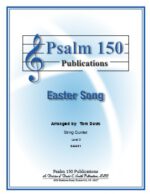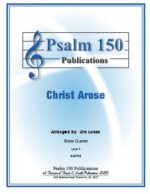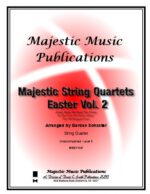-
-
The Old Rugged Cross
$4.00This moderately easy violin solo begins with a soulful harmonic progression in the accompaniment (alla Moonlight Sonata) that introduces the melody in a 3-4 meter. The theme is presented in its entirety. After a brief modulation the accompaniment takes over in a rich melodic/harmonic interplay of the tune and supporting lines, only to be joined with a simple counter line in the solo. The piece gains strength with the rhythmic interplay between the soloists and the accompaniment and then calms to a style presented in the opening measures. Final rest.
-
The Old Rugged Cross
$4.00This moderately easy clarinet solo begins with a soulful harmonic progression in the accompaniment (alla Moonlight Sonata) that introduces the melody in a 3-4 meter. The theme is presented in its entirety. After a brief modulation the accompaniment takes over in a rich melodic/harmonic interplay of the tune and supporting lines, only to be joined with a simple counter line in the solo. The piece gains strength with the rhythmic interplay between the soloists and the accompaniment and then calms to a style presented in the opening measures. Final rest.
-
Christ The Lord Is Risen Today
$30.00(in manuscript at this time)(as recorded by the Hollywood Bowl Orchestra) 22 or more brass with organ and percussion; C and D trumpets required (as rec’d by the Hollywood Bowl Orch)
-
The Old Rugged Cross
$10.00The introduction of this brass sextet (3 Trp., 3 Trom.) begins with strong choral movement and then settles into repose. The first presentation of the tune is in the trombones with a subtle counterline in the trumpets which then opens up to a stronger movement with the melody in the trumpet. The tune then reverts back to the trombones and then transitions to a move active support pattern in the trombones with a solo in the second trumpet. The final section gives way to a powerful presentation of the tune and immediately settles into a sensitive climate, much like the beginning. After a DC the piece ends with the strong motifs of the introduction giving a sense of finality. (Opt Horn for 1st Trom.)
-
-
-
-
The Love Of God
$20.00(ww, solo trombone and piano) opt strings and percussion(in manuscript at this time)
-
The Old Rugged Cross
$4.00This moderately easy oboe solo begins with a soulful harmonic progression in the accompaniment (alla Moonlight Sonata) that introduces the melody in a 3-4 meter. The theme is presented in its entirety. After a brief modulation the accompaniment takes over in a rich melodic/harmonic interplay of the tune and supporting lines, only to be joined with a simple counter line in the solo. The piece gains strength with the rhythmic interplay between the soloists and the accompaniment and then calms to a style presented in the opening measures. Final rest.
-
-
In The Garden
$6.00The piece begins with an arpeggiated paino (alla harp) and then joined by tutti flutes. The theme is stated in the fashion unilt it breaks into a flute trio harmonization, with more vigor. The piece gravitates to a new key where any of the parts can serve as the soloist. The final section is stronger and again uses the benefit of the flute trio harmonies. It progresses to a gentle and quiet repose as if in a pastorale setting.
-
-
The Old Rugged Cross
$4.00This moderately easy flute solo begins with a soulful harmonic progression in the accompaniment (alla Moonlight Sonata) that introduces the melody in a 3-4 meter. The theme is presented in its entirety. After a brief modulation the accompaniment takes over in a rich melodic/harmonic interplay of the tune and supporting lines, only to be joined with a simple counter line in the solo. The piece gains strength with the rhythmic interplay between the soloists and the accompaniment and then calms to a style presented in the opening measures. Final rest.
-
O Sacred Head, Now Wounded
$12.95A traditional string quartet with two violins, viola and cello. The beginning section is presented in a somber manner with “con sordino” The phrases are gentle and simplistic with subtle harmonic movements. The second section is “con sordino” and gains in intensity where it reaches a real strong point and the settles down to a real sense of conclusion.
-

























